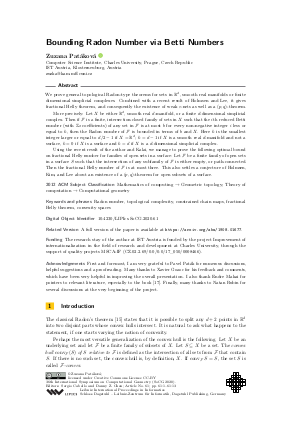@InProceedings{patakova:LIPIcs.SoCG.2020.61,
author = {Pat\'{a}kov\'{a}, Zuzana},
title = {{Bounding Radon Number via Betti Numbers}},
booktitle = {36th International Symposium on Computational Geometry (SoCG 2020)},
pages = {61:1--61:13},
series = {Leibniz International Proceedings in Informatics (LIPIcs)},
ISBN = {978-3-95977-143-6},
ISSN = {1868-8969},
year = {2020},
volume = {164},
editor = {Cabello, Sergio and Chen, Danny Z.},
publisher = {Schloss Dagstuhl -- Leibniz-Zentrum f{\"u}r Informatik},
address = {Dagstuhl, Germany},
URL = {https://drops.dagstuhl.de/entities/document/10.4230/LIPIcs.SoCG.2020.61},
URN = {urn:nbn:de:0030-drops-122198},
doi = {10.4230/LIPIcs.SoCG.2020.61},
annote = {Keywords: Radon number, topological complexity, constrained chain maps, fractional Helly theorem, convexity spaces}
}

 Creative Commons Attribution 3.0 Unported license
Creative Commons Attribution 3.0 Unported license







